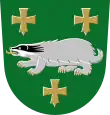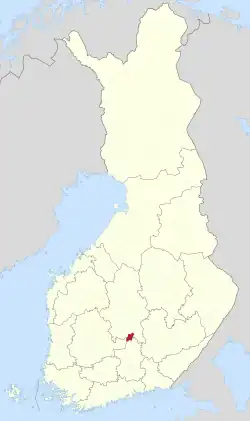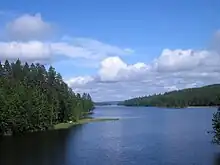Luhanka | |
|---|---|
Municipality | |
| Luhangan kunta Luhanka kommun | |
 | |
 Coat of arms | |
 Location of Luhanka in Finland | |
| Coordinates: 61°48′N 025°42′E / 61.800°N 25.700°E | |
| Country | |
| Region | Central Finland |
| Sub-region | Joutsa sub-region |
| Charter | 1864 |
| Government | |
| • Municipal manager | Reijo Urtti |
| Area (2018-01-01)[1] | |
| • Total | 313.25 km2 (120.95 sq mi) |
| • Land | 214.5 km2 (82.8 sq mi) |
| • Water | 98.73 km2 (38.12 sq mi) |
| • Rank | 256th largest in Finland |
| Population (2023-09-30)[2] | |
| • Total | 691 |
| • Rank | 300th largest in Finland |
| • Density | 3.22/km2 (8.3/sq mi) |
| Population by native language | |
| • Finnish | 99.4% (official) |
| • Others | 0.6% |
| Population by age | |
| • 0 to 14 | 8.4% |
| • 15 to 64 | 49.9% |
| • 65 or older | 41.6% |
| Time zone | UTC+02:00 (EET) |
| • Summer (DST) | UTC+03:00 (EEST) |
| Website | www |
Luhanka (Swedish: Luhanka, also Luhango) is a municipality of Finland. It is located in the Central Finland region. The municipality has a population of 691 (30 September 2023)[2] and covers an area of 313.25 square kilometres (120.95 sq mi) of which 98.73 km2 (38.12 sq mi) is water.[1] In relation to its population Luhanka is not just the smallest municipality in the region but also smallest in the whole Mainland Finland.
The population density is 3.22 inhabitants per square kilometre (8.3/sq mi). There are also many summertime cottages in Luhanka.
The municipality is unilingually Finnish. The municipality is also been known as "Luhango" in Swedish documents.[5]
Mimicking the badger in the coat of arms of Luhanka, the permanent residents include the official animal mascot of the municipality, Sisu the Badger (Sisu-mäyrä).[6]
Geography

Neighboring municipalities are Hartola, Joutsa, Jyväskylä, Jämsä, Kuhmoinen and Sysmä.
There are all together 61 lakes in Luhanka. Biggest lakes in Luhanka are Päijänne, Tammijärvi-Hauha and Jutilanjärvi.[7]
History
Luhanka was first mentioned as a village within the Sysmä parish in 1462. The village gets its name from the lake Luhankjärvi or Luhankajärvi, the name of which comes from the word luha, a variant of luhta, a word which refers to a type of swamp. -nka is a derivational suffix, which is also found in other place names such as Puolanka and Maaninka.
It was granted a chapel in 1767 and became a separate parish in 1864. Due to the small population of the municipality, the parish of Luhanka became subordinate to the parish of Joutsa in 2006.[8][9]
Notable people
- Politician Hertta Kuusinen was born in Luhanka in 1904
- Writer Kreetta Onkeli has spent childhood in Luhanka
- Composer Toni Edelmann lived in Luhanka
References
- 1 2 "Area of Finnish Municipalities 1.1.2018" (PDF). National Land Survey of Finland. Retrieved 30 January 2018.
- 1 2 "Preliminary population statistics 2023, September". StatFin. Statistics Finland. Retrieved 26 October 2023.
- ↑ "Demographic Structure by area as of 31 December 2022". Statistics Finland's PX-Web databases. Statistics Finland. Retrieved 6 September 2023.
- ↑ "Population according to age (1-year) and sex by area and the regional division of each statistical reference year, 2003–2020". StatFin. Statistics Finland. Retrieved 2 May 2021.
- ↑ "Svenska ortnamn i Finland" (in Swedish). Research Institute for the Languages of Finland. 25 October 2012. Retrieved 25 October 2012.
- ↑ Mäyrä-maskotti sai nimen (in Finnish)
- ↑ "Luhanka". Järviwiki. Finland's Environmental Administration. 2012. Retrieved 27 February 2012.
- ↑ "SuomalainenPaikannimikirja_e-kirja_kuvallinen.pdf" (PDF). kaino.kotus.fi (in Finnish). p. 244. Retrieved August 16, 2022.
- ↑ "Luhangan seurakunta". joutsanseurakunta.filanguage=fi. Retrieved August 16, 2022.
External links
 Media related to Luhanka at Wikimedia Commons
Media related to Luhanka at Wikimedia Commons- Municipality of Luhanka – Official homepage (in Finnish)